Superpave沥青混合料设计方法
- 格式:pdf
- 大小:787.62 KB
- 文档页数:9
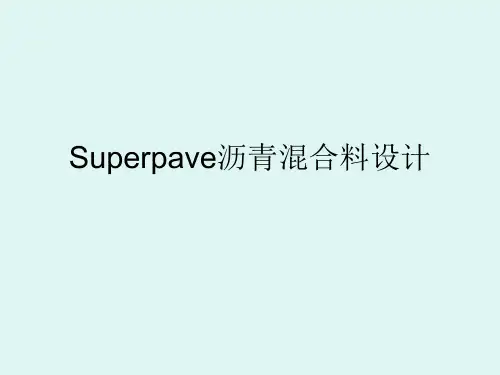
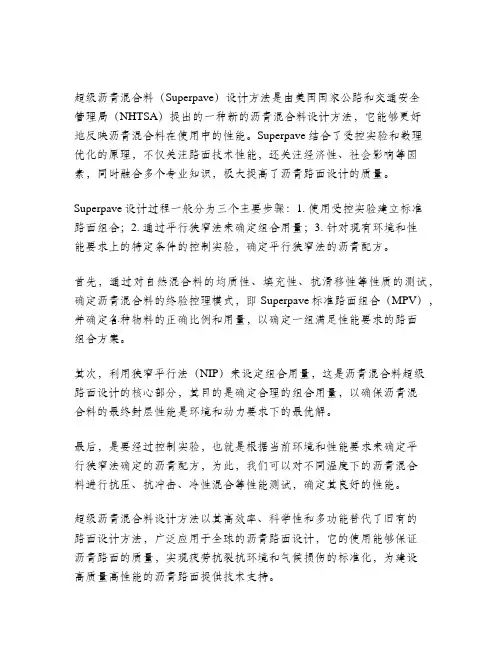
超级沥青混合料(Superpave)设计方法是由美国国家公路和交通安全
管理局(NHTSA)提出的一种新的沥青混合料设计方法,它能够更好
地反映沥青混合料在使用中的性能。
Superpave结合了受控实验和数理
优化的原理,不仅关注路面技术性能,还关注经济性、社会影响等因素,同时融合多个专业知识,极大提高了沥青路面设计的质量。
Superpave设计过程一般分为三个主要步骤:1. 使用受控实验建立标准
路面组合;2. 通过平行狭窄法来确定组合用量;3. 针对现有环境和性
能要求上的特定条件的控制实验,确定平行狭窄法的沥青配方。
首先,通过对自然混合料的均质性、填充性、抗滑移性等性质的测试,确定沥青混合料的终验控理模式,即Superpave标准路面组合(MPV),并确定各种物料的正确比例和用量,以确定一组满足性能要求的路面
组合方案。
其次,利用狭窄平行法(NIP)来设定组合用量,这是沥青混合料超级路面设计的核心部分,其目的是确定合理的组合用量,以确保沥青混
合料的最终封层性能是环境和动力要求下的最优解。
最后,是要经过控制实验,也就是根据当前环境和性能要求来确定平
行狭窄法确定的沥青配方,为此,我们可以对不同温度下的沥青混合
料进行抗压、抗冲击、冷性混合等性能测试,确定其良好的性能。
超级沥青混合料设计方法以其高效率、科学性和多功能替代了旧有的
路面设计方法,广泛应用于全球的沥青路面设计,它的使用能够保证
沥青路面的质量,实现疲劳抗裂抗环境和气候损伤的标准化,为建设
高质量高性能的沥青路面提供技术支持。
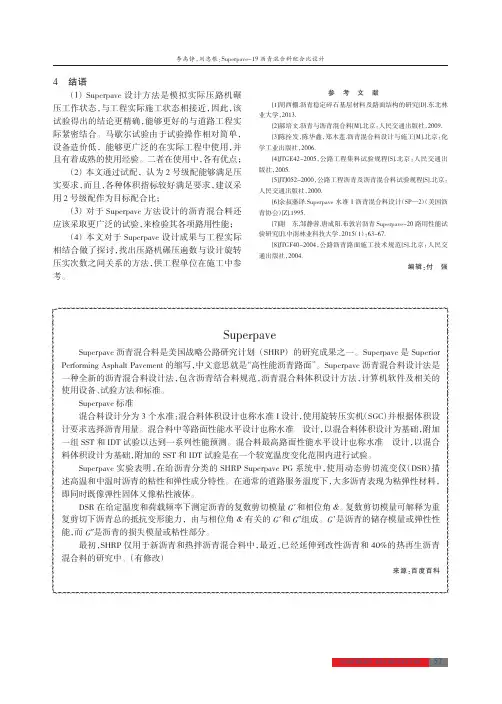
NORTHERN ARCHITECTURESuperpaveSuperpave 沥青混合料是美国战略公路研究计划(SHRP )的研究成果之一。
Superpave 是SuperiorPerforming Asphalt Pavement 的缩写,中文意思就是“高性能沥青路面”。
Superpave 沥青混合料设计法是一种全新的沥青混合料设计法,包含沥青结合料规范,沥青混合料体积设计方法,计算机软件及相关的使用设备、试验方法和标准。
Superpave 标准混合料设计分为3个水准:混合料体积设计也称水准I 设计,使用旋转压实机(SGC )并根据体积设计要求选择沥青用量。
混合料中等路面性能水平设计也称水准Ⅱ设计,以混合料体积设计为基础,附加一组SST 和IDT 试验以达到一系列性能预测。
混合料最高路面性能水平设计也称水准Ⅲ设计,以混合料体积设计为基础,附加的SST 和IDT 试验是在一个较宽温度变化范围内进行试验。
Superpave 实验表明,在给沥青分类的SHRP Superpave PG 系统中,使用动态剪切流变仪(DSR )描述高温和中温时沥青的粘性和弹性成分特性。
在通常的道路服务温度下,大多沥青表现为粘弹性材料,即同时既像弹性固体又像粘性液体。
DSR 在给定温度和荷载频率下测定沥青的复数剪切模量G ′和相位角&。
复数剪切模量可解释为重复剪切下沥青总的抵抗变形能力,由与相位角&有关的G ′和G ″组成。
G ′是沥青的储存模量或弹性性能,而G ″是沥青的损失模量或粘性部分。
最初,SHRP 仅用于新沥青和热拌沥青混合料中,最近,已经延伸到改性沥青和40%的热再生沥青混合料的研究中。
(有修改)来源:百度百科4结语(1)Superpave 设计方法是模拟实际压路机碾压工作状态,与工程实际施工状态相接近,因此,该试验得出的结论更精确,能够更好的与道路工程实际紧密结合。
马歇尔试验由于试验操作相对简单,设备造价低,能够更广泛的在实际工程中使用,并且有着成熟的使用经验。
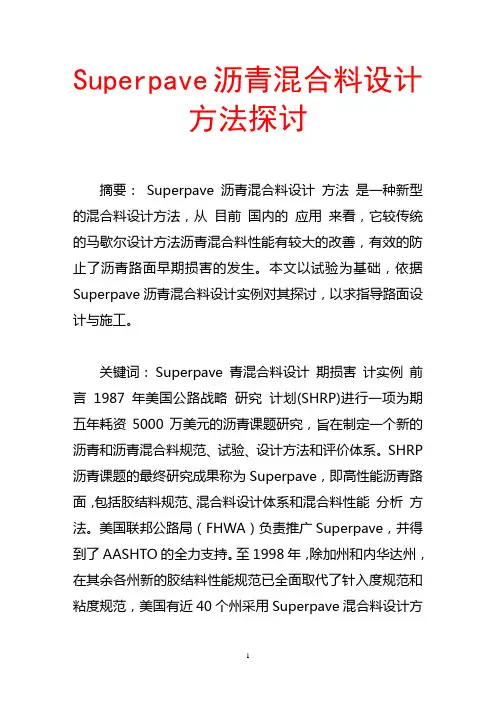
Superpave沥青混合料设计方法探讨摘要: Superpave沥青混合料设计方法是一种新型的混合料设计方法,从目前国内的应用来看,它较传统的马歇尔设计方法沥青混合料性能有较大的改善,有效的防止了沥青路面早期损害的发生。
本文以试验为基础,依据Superpave沥青混合料设计实例对其探讨,以求指导路面设计与施工。
关键词: Superpave 青混合料设计期损害计实例前言 1987年美国公路战略研究计划(SHRP)进行一项为期五年耗资5000万美元的沥青课题研究,旨在制定一个新的沥青和沥青混合料规范、试验、设计方法和评价体系。
SHRP沥青课题的最终研究成果称为Superpave,即高性能沥青路面,包括胶结料规范、混合料设计体系和混合料性能分析方法。
美国联邦公路局(FHWA)负责推广Superpave,并得到了AASHTO 的全力支持。
至1998年,除加州和内华达州,在其余各州新的胶结料性能规范已全面取代了针入度规范和粘度规范,美国有近40个州采用Superpave混合料设计方法取代马歇尔混合料设计方法。
目前我国的Superpave技术的引进和应用较为普遍,国内许多单位都纷纷购买购买和采用Superpave体系的设备和仪器,Superpave沥青胶结料规范和混合料设计规范在许多项目中已被应用。
从实际路面运营的效果来看,其展现出比传统的AC类沥青混合料很多性能上的优势,有效的防止了沥青路面早期损害的发生。
本文基于已有的研究,以试验为基础,依据Sup20改性沥青混合料配合比设计实例对Superpave混合料设计方法进行探讨。
1Sup20改性沥青混合料设计实例 1.1 集料技术性质试验试验选用石料为石灰岩石料、沥青为科氏161SBS 改性沥青,依据Superpave 设计要求,进行了集料技术性质试验,结果如下表所示:表1-1 集料技术性质试验结果汇总表试验项目试验值设计标准 Superpave技术标准集料认同特性粗集料棱角性(%) 100 / ≥100%细集料棱角(%) 46.0 / 45%扁平颗粒(%) 5.6 ≤15 10%砂当量(%) 85.6 ≥70 60%集料料源特性坚固性(%) 17.5 ≤30 35~45%安定性(%) 3.3 ≤12 10~20% 注:对于集料的料源特性,Superpave技术标准无具体要求,表中列出的标准为推荐值。
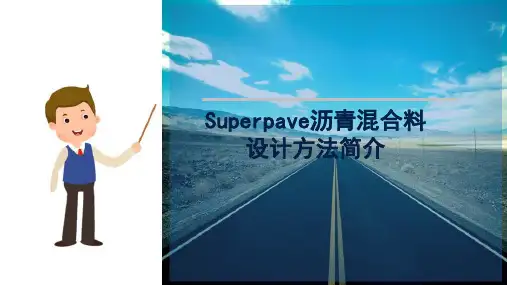

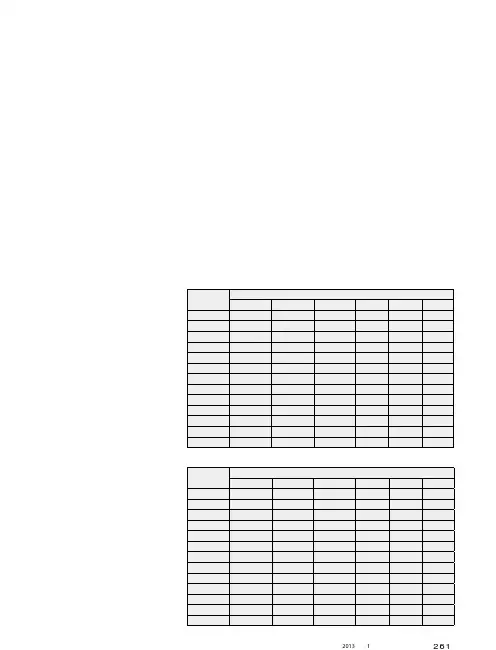
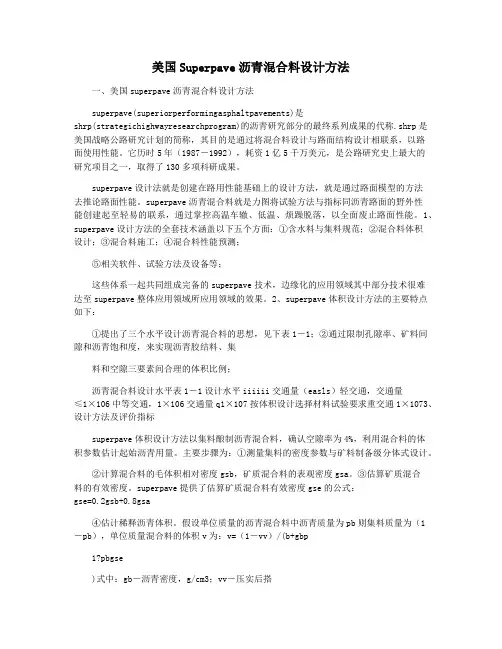
美国Superpave沥青混合料设计方法一、美国superpave沥青混合料设计方法superpave(superiorperformingasphaltpavements)是shrp(strategichighwayresearchprogram)的沥青研究部分的最终系列成果的代称.shrp是美国战略公路研究计划的简称,其目的是通过将混合料设计与路面结构设计相联系,以路面使用性能。
它历时5年(1987―1992),耗资1亿5千万美元,是公路研究史上最大的研究项目之一,取得了130多项科研成果。
superpave设计法就是创建在路用性能基础上的设计方法,就是通过路面模型的方法去推论路面性能。
superpave沥青混合料就是力图将试验方法与指标同沥青路面的野外性能创建起至轻易的联系,通过掌控高温车辙、低温、烦躁脱落,以全面废止路面性能。
1、superpave设计方法的全套技术涵盖以下五个方面:①含水料与集料规范;②混合料体积设计;③混合料施工;④混合料性能预测;⑤相关软件、试验方法及设备等;这些体系一起共同组成完备的superpave技术,边缘化的应用领域其中部分技术很难达至superpave整体应用领域所应用领域的效果。
2、superpave体积设计方法的主要特点如下:①提出了三个水平设计沥青混合料的思想,见下表1―1;②通过限制孔隙率、矿料间隙和沥青饱和度,来实现沥青胶结料、集料和空隙三要素间合理的体积比例;沥青混合料设计水平表1―1设计水平iiiiii交通量(easls)轻交通,交通量≤1×106中等交通,1×106交通量q1×107按体积设计选择材料试验要求重交通1×1073、设计方法及评价指标superpave体积设计方法以集料酿制沥青混合料,确认空隙率为4%,利用混合料的体积参数估计起始沥青用量。
主要步骤为:①测量集料的密度参数与矿料制备级分体式设计。
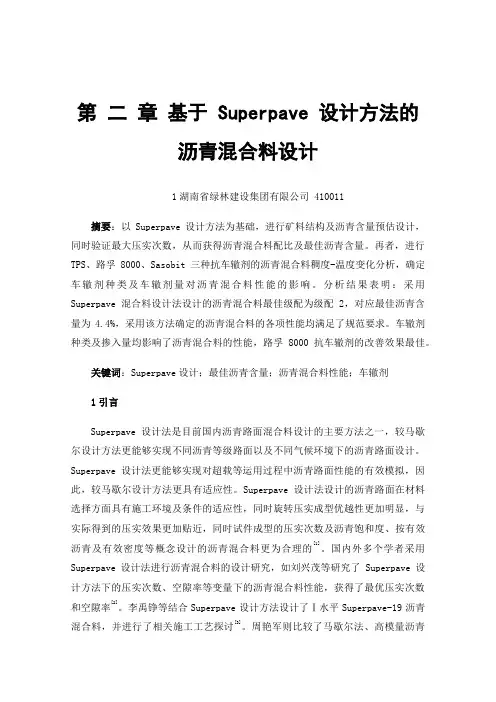
第二章基于 Superpave 设计方法的沥青混合料设计1湖南省绿林建设集团有限公司 410011摘要:以Superpave设计方法为基础,进行矿料结构及沥青含量预估设计,同时验证最大压实次数,从而获得沥青混合料配比及最佳沥青含量。
再者,进行TPS、路孚8000、Sasobit三种抗车辙剂的沥青混合料稠度-温度变化分析,确定车辙剂种类及车辙剂量对沥青混合料性能的影响。
分析结果表明:采用Superpave混合料设计法设计的沥青混合料最佳级配为级配2,对应最佳沥青含量为4.4%,采用该方法确定的沥青混合料的各项性能均满足了规范要求。
车辙剂种类及掺入量均影响了沥青混合料的性能,路孚8000抗车辙剂的改善效果最佳。
关键词:Superpave设计;最佳沥青含量;沥青混合料性能;车辙剂1引言Superpave设计法是目前国内沥青路面混合料设计的主要方法之一,较马歇尔设计方法更能够实现不同沥青等级路面以及不同气候环境下的沥青路面设计。
Superpave设计法更能够实现对超载等运用过程中沥青路面性能的有效模拟,因此,较马歇尔设计方法更具有适应性。
Superpave设计法设计的沥青路面在材料选择方面具有施工环境及条件的适应性,同时旋转压实成型优越性更加明显,与实际得到的压实效果更加贴近,同时试件成型的压实次数及沥青饱和度、按有效沥青及有效密度等概念设计的沥青混合料更为合理的[1]。
国内外多个学者采用Superpave设计法进行沥青混合料的设计研究,如刘兴茂等研究了Superpave设计方法下的压实次数、空隙率等变量下的沥青混合料性能,获得了最优压实次数和空隙率[2]。
李禹铮等结合Superpave设计方法设计了Ⅰ水平Superpave-19沥青混合料,并进行了相关施工工艺探讨[3]。
周艳军则比较了马歇尔法、高模量沥青混凝土设计方法、Superpave混合料设计方法三种方法的优缺点,展现了Superpave混合料设计方法的优越性[4]。
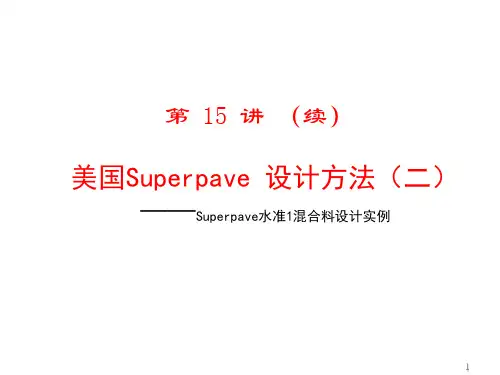
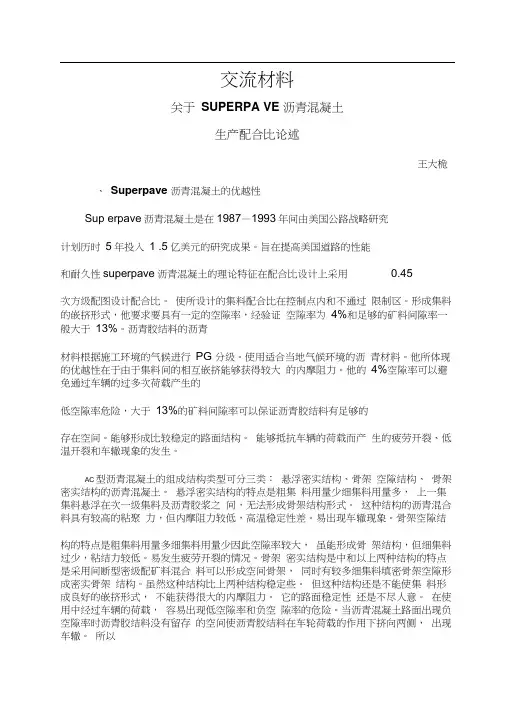
交流材料关于SUPERPA VE 沥青混凝土生产配合比论述王大桅、Superpave 沥青混凝土的优越性Sup erpave沥青混凝土是在1987—1993年间由美国公路战略研究计划历时5年投入1 .5亿美元的研究成果。
旨在提高美国道路的性能和耐久性superpave沥青混凝土的理论特征在配合比设计上采用0.45次方级配图设计配合比。
使所设计的集料配合比在控制点内和不通过限制区。
形成集料的嵌挤形式,他要求要具有一定的空隙率,经验证空隙率为4%和足够的矿料间隙率一般大于13%。
沥青胶结料的沥青材料根据施工环境的气候进行PG 分级。
使用适合当地气候环境的沥青材料。
他所体现的优越性在于由于集料间的相互嵌挤能够获得较大的内摩阻力。
他的4%空隙率可以避免通过车辆的过多次荷载产生的低空隙率危险,大于13%的矿料间隙率可以保证沥青胶结料有足够的存在空间。
能够形成比较稳定的路面结构。
能够抵抗车辆的荷载而产生的疲劳开裂、低温开裂和车辙现象的发生。
AC型沥青混凝土的组成结构类型可分三类:悬浮密实结构、骨架空隙结构、骨架密实结构的沥青混凝土。
悬浮密实结构的特点是粗集料用量少细集料用量多,上一集集料悬浮在次一级集料及沥青胶浆之间,无法形成骨架结构形式。
这种结构的沥青混合料具有较高的粘聚力,但内摩阻力较低,高温稳定性差。
易出现车辙现象。
骨架空隙结构的特点是粗集料用量多细集料用量少因此空隙率较大,虽能形成骨架结构,但细集料过少,粘结力较低。
易发生疲劳开裂的情况。
骨架密实结构是中和以上两种结构的特点是采用间断型密级配矿料混合料可以形成空间骨架,同时有较多细集料填密骨架空隙形成密实骨架结构。
虽然这种结构比上两种结构稳定些。
但这种结构还是不能使集料形成良好的嵌挤形式,不能获得很大的内摩阻力。
它的路面稳定性还是不尽人意。
在使用中经过车辆的荷载,容易出现低空隙率和负空隙率的危险。
当沥青混凝土路面出现负空隙率时沥青胶结料没有留存的空间使沥青胶结料在车轮荷载的作用下挤向两侧,出现车辙。
Superpave简介Superpave是Superior Performing Asphalt Pavement的缩写,中文意思就是“高性能沥青路面”。
Superpave沥青混合料是美国战略公路研究计划(SHRP)的研究成果之一。
Superpave沥青混合料设计法是一种全新的沥青混合料设计法,包含沥青结合料规范,沥青混合料体积设计方法,计算机软件及相关的使用设备、试验方法和标准。
Sperpave混合料设计分为三个水准:混合料体积设计也称水准I设计,使用旋转压实机(SGC)并根据体积设计要求选择沥青用量。
混合料中等路面性能水平设计也称水准II设计,以混合料体积设计为基础,附加一组SST和IDT试验以达到一系列性能预测。
混合料最高路面性能水平设计也称水准III设计,以混合料体积设计为基础,附加的SST和IDT试验是在一个较宽温度变化范围内进行试验。
由于包含了更广泛的试验范围和结果,完全分析可提供更可靠的性能预测水平。
Superpave沥青混合料设计系统是根据项目所在地的气候和设计交通量,把材料选择与混合料设计都集中在体积设计法中,该方法要求在设计沥青路面时,充分考虑在服务期内温度对路面地影响,要求路面在最高设计温度时能满足高温性能地要求,不产生过量地车辙;在路面最低温度时,能满足低温性能地要求,避免或减少低温开裂;在常温范围内控制疲劳开裂。
对于沥青结合料,采用旋转薄膜烘箱试验来模拟沥青混合料在拌和和摊铺工程中的老化;采用压力老化容器模拟沥青在路面使用工程中的老化。
对于集料,在进行混合料级配设计时,采用控制点和限制区的概念来限定,优选试验级配设计。
对于沥青混合料,在拌好后,采用短期老化来模拟沥青混合料在拌和摊铺压实过程中的老化,沥青混合料试件采用旋转压实仪准备。
试件压实过程中,记录旋转压实次数与试件高度的关系,从而对沥青混合料体积特性进行评价。
所谓Superpave混合料体积设计是根据沥青混合料的空隙率、矿料间隙率、沥青填隙率等体积特性进行热拌沥青混合料设计的,方法主要有设计材料选择、沥青混合料拌和、沥青混合料体积分析以及混合料验证,包括体积性质和水敏感性。
Superpave沥青混合料的配合比设计与应用于2000年,我国的京珠高速公路湖北段首次引进了Superpave试验路,同年,在江苏省内的淮江公路淮阴连接线也进行了7km的Superpave沥青路面的施工。
之后的连徐、宁宿徐和宁靖盐等高速公路也进行了Superpave上、中、下面层的试验路。
Superpave技术在江苏省内的应用逐步得以推广。
2004年通启高速公路共线段沥青中、下面层设计分别采用了Superpave20和Superpave25的结构。
虽然该路段为六车道,路幅较宽,但两台摊铺机摊铺后的混合料表面均匀,基本无离析,且基本不渗水。
至2008年在如东S334沥青路面中我又再遇Superpave 沥青砼,现结合多条道路施工经验,浅析Superpave沥青混合料的设计与应用。
一、Superpave设计原理我们在进行沥青混合料配合比设计时,通常做法是千方百计调整级配尽可能符合规范规定的中值,特别强调“应使包括0.075mm、2.36mm和4.75mm的筛孔在内的较多的通过量接近设计级配范围的中值”。
在0.45次级配图上,我们可以发现大多数级配中值点接近最大密度线。
也就是说,使沥青混合料能最大限度的密实是沥青混合料设计的原理。
而Superpave设计则认为随着交通量的增长,轴载的增加,我们需要更多的粗集料形成骨架,有足够的矿料间隙率和足够的沥青保持耐久性,并具有一定的空隙率使沥青能够自由迁移,这就是Superpave的设计概念。
二、级配确定根据Superpave设计原理,Superpave的集料级配控制就完全不同于我国沥青路面技术规范的级配范围,主要采用控制点和限制区来初选级配,总体要求就是尽可能使较大的粗集料通过量多一些,而较小的粗集料通过量少一些,同时要求细集料一端不能通过规定的限制区,一般曲线均走限制区的下方,也就是限制混合料中细集料的含量。
下面我就将普通AC-25Ⅰ、AC-20Ⅰ型沥青混合料与Sup25和Sup20级配绘图进行对比。
高性能沥青路面(Superpave)混合料配合比设计摘要:随着经济的迅速发展,甘肃省沥青路面公路建设在应用越来越广泛,人们对于公路工程沥青路面的行车安全、行车速度及行车舒适度等都提出了更高的要求。
而沥青路面的配合比设计是施工技术与质量控制关键因素,因此在公路沥青路面施工过程中,应不断完善配合比设计,加强对整个工程的质量控制,从而确保公路沥青路面施工质量。
关键词:Superpave 沥青混合料目标配合比1 Superpave结构沥青混合料特点1)Superpave混合料在设计过程中充分考虑到了气候环境条件和交通量的影响,试件成型采用旋转压实的方法模拟路面的实际施工过程。
2)集料级配更趋于嵌挤、密实,高温稳定性好,适于交通量大和抗车辙要求高的公路。
3)在施工确保合适空隙率的前提下,抗水害性能和抗疲劳性能也较好。
2 Superpave结构沥青混合料目标配合比设计1)设计流程2)级配要求2.1)级配分类:混合料级配分成粗级配和细级配,当级配主要控制筛(PCS)的通过率小于下表主要控制点通过率时,定义为粗级配,其他级配为细级配。
2.2)最大密度级配:最大密度级配表示一种集料颗粒以最密实的方式排列在一起的级配。
是种要避免的级配,因为这样就会在集料中有极少的空间,因而不能有足够厚度的沥青膜以形成耐久性结构。
2.3)控制点:控制点的功能为级配必须通过的范围,设置在公称最大尺寸、中等尺寸(2.36mm)和粉尘尺寸(0.075m)。
2.4)限制区:限制区在最大密度级配线附近,在中等尺寸(475mm或2.36m,取决于最大尺寸)和0.30mm尺寸之间,形成一个级配不应通过的区域,通过限制区的级配被称为“驼峰级配”。
因为通过限制区的级配曲线,会引起混合料变软,导致混合料抗永久变形能力下降。
2.5)设计集料结构:用以描述集料颗粒尺寸累计分布的术语叫设计集料结构。
位于控制点之间并避开限制区的设计集料结构满足 Superpave级配的要求。
沥青与沥青混合料课程论文Method for the Design of Superpave Asphalt Mixture院系:土木工程班级:道路2班学号:201301010809姓名:王弘宇2017-01-05Abstract: Based on the brief introduction of the method for the design of Superpave Asphalt Mixture, the differences between Superpave and Marshall Design Method are discussed in the aspects of Molding Method, V olume Calculation and Optimum Asphalt Dosage, by comparing Superpave and Marshall Method for the design of Asphalt Mixture, and give some suggestions on Marshall Method.Key words: highway; asphalt mixture; Superpave Design Method; Marshall Design MethodDue to the rapid increase of traffic volume, tire pressure and axial load, as well as the changes in environment and material, asphalt pavement technology is facing a huge change. A lot of practice has proved that the relationship between Marshall Stability, flow value and the long-term performance of asphalt pavement is not significant, usually the high-temperature rut of the asphalt pavement whose flow value is qualified is still very serious. Asphalt penetration specification that has been used for nearly a century and Marshall Asphalt Mixture design method that has been used for nearly half a century cannot control the destruction of asphalt pavement, Early Damages of a lot of pavements which met the existing norms, designed according to the traditional method still occurred, which cannot be separated with its limitations. Therefore, it is necessary to realize the transition from the traditional empirical method to the road-performance-oriented method so as to prolong the service life of the asphalt pavement.1Brief introduction of Superpave Design MethodStrategic Highway Research Program (SHRP), which was completed in 1993, proposed a method of kneading molding specimens using a Superpave Gyratory Compactor (SGC). This molding method establishes a closer relationship between compaction conditions and traffic conditions, and the compaction process is closer to the compaction effect of actual pavement, reducing the crush of aggregate in the compaction process, the arrangement of the aggregate shape is closer to conditions of actual pavement.Height measurement of the test specimen is an important function of SGC. In compaction process, the density of the specimen can be estimated by the mass of the material, the inner diameter of the test-piece and the height of the specimen. The height is measured by recording the position of the loading head during the experiment, and the compaction properties of the specimen are obtained from these measurements.In Superpave, the compaction level is a function of N, which is the design Gyratory Compaction frequency. The design value of N is used to distinguish the different compaction functions of the design mixture, which is a function of traffic level. Traffic level is expressed by Equivalent Standard Axle Loads (ESALs). Therange of the design values of N is shown in Table 1.The optimum Asphalt-Aggregate Ratio of each asphalt mixture was determined by Superpave V olume Method. First, test an amount of asphalt, and the bulk density of the test specimens was measured by the surface-dry condition method.Table 1. Gyratory Compaction frequency of SuperpaveDesign ESALs/×106roundGyratory Compactionfrequency N/roundApplication of typicalroadInitialvalueDesignvalueMaximumvalue<0.3 6 50 75 Light traffic volume (local/county road)0.3~3 7 75 115 Medium traffic volume (most county roads)3~30 8 100 160 Medium to heavy traffic volume (city street,national highway)≥30 9 125 205 Heavy traffic volume (most interstates,climbing roads)2Comparison of Superpave and Marshall for the design method of Asphalt Mixture2.1Molding MethodCompared with Marshall Compaction Method, the main advantages of SGC gyratory compaction method are: to establish a closer relationship between compaction conditions and traffic volume conditions; the compaction process is closer to the compaction effect of actual pavement; reducing the crush of aggregate in the compaction process; the arrangement of the aggregate shape is closer to conditions of actual pavement; full consideration of the compaction properties of the Mixture, and to establish a relationship according to the compaction properties and the Construction Stability of Mixture as well as the High Temperature Stability of Mixture.Due to the vast expense of a whole set of SGC gyratory compaction equipment, Marshall Compaction instrument is at present widely used in China. In view of this situation, we can learn from SGC compaction method to improve the existing Marshall Compaction Method: It is recommended using large-scale test specimen compaction method for the Mixture which is large particle size, in other words, the mixture is made into a large cylindrical specimen, test it by using the large Marshall Test instrument, and establish the standard of the mechanics index of Marshall Testwhich is suitable for the large-scale standard specimen. The relationship between the times of compaction and the design traffic volume is established to make the compaction standard more reasonable.2.2The Method of Volume CalculationThe volume calculation of Superpave Design Method is different from traditional Marshall Method. The former takes into account the issue of aggregate asphalt absorption, using a four-phase system (air, absorbed asphalt, effective asphalt and aggregate) to calculate the volume; the latter uses a three-phase system (air, asphalt and aggregate), without considering the situation of aggregate asphalt absorption. Since the aggregates composing the asphalt mixture have different numbers of voids, they absorb a certain amount of the asphalt binder during the mixing, spreading and use of the asphalt mixture. The asphalt absorbed by mineral aggregate generally does not affect the strength of the asphalt mixture, so the volume index calculated by Superpave Design Method is more realistic.2.3Optimum Asphalt DosageThe advantage of Superpave Design Method is to ensure that there is a 4% voidage of the mixture, but the voidage is sometimes small in the final selection of the amount of asphalt by Marshall Method, which may cause Early Damages.3The superiority of Superpave design system1)It is more realistic than the traditional empirical method to select the asphaltbinder according to the local climatic conditions and traffic volume, trafficconditions, which is more rational use of materials.2)Selecting aggregate structure according to the control point and the restrictedarea, the volume index of the mixture can meet the design requirements moreeasily.3)Using SGC to mold asphalt mixture can be more realistically than MarshallMethod to compact the mixture to the condition that road construction can,and it is able to identify potentially unstable mixture, to avoid early damageto the road.4)When Gyratory Compaction is adopted, different gyratory compaction timescan be used, the change of voidage can be predicted after long-term load, andto find the problems in time, which can provide reference for thedetermination of gradation.5)Gyratory Compaction uses a large test specimen with a diameter of 150 mm.Aggregates with large grain size can be evenly distributed throughout thespecimen, reducing the variability of the test results of the Marshall specimendue to the small size.4Design of Superpave Asphalt Mixture4.1Selection of raw materials1)Selection of Asphalt BinderDetermine the PG grade that the asphalt binder should meet according to the local climatic conditions and traffic volume, traffic conditions, select the appropriate asphalt binder.2)Selection of aggregateThe main aggregate tests are shown in Table 2.4.2Selection of GradationIn order to introduce the design method of Superpave Asphalt Mixture more concretely, this paper designs with 3 grads (see Table 3). A total of 109 rotations were carried out in the test, which were suitable for the highways of medium to heavy traffic volume. The calculated volume index of the asphalt mixture is shown in Table 4.At the same time, the specimens AC-13 with the Asphalt-Aggregate Ratio of 5.4%, SMA-13 with 6.0%, OGFC-13 with 3.0% were molded, measured the Residual V oidage of the specimens after rotating and compacting 160 times by SGC. The Residual V oidage of the specimens was 2.9%, 2.7% and 13.0% respectively, which met the requirements.Table 3. Three gradations used in the designType of MixturePercentage of mass passing through the following sieve openings (mm)/% 26.5 19 16 13.2 9.5 4.75 2.36 1.18 0.6 0.3 0.15 0.075AC-13 100 100 100 93.0 68.0 46.0 27.0 23.0 15.0 13.0 9.0 8.0 SMA-13 100 100 100 95.0 62.5 27.0 20.5 19.0 16.0 13.0 12.0 10.0 OGFC-13 100 100 100 93.3 67.8 23.0 13.8 10.2 8.1 6.3 5.1 4.1Table 4. Determination results of Asphalt Mixture volume indexType of Mixture OptimumAAR/%Bulk Density/g·cm-3VV/%VMA/%DPVF A/%AC-13 5.4 2.293 3.9 15.3 1.2 75.0 SMA-13 6.0 2.215 3.8 16.1 1.5 77.8 OGFC-13 3.0 2.490 14.1 ---TechnicalStandardmeasured measured 4.0 ≥14 0.8~1.6 65~754.3Selection of Optimum Asphalt DosageAccording to the selected gradation, the different asphalt dosages are selected, then Gyratory Compaction specimen is made according to the viscosity-temperature curve, evaluate the volume index related to the mixture, then determine Optimum Asphalt Dosage. See Figure 1.Figure 1. Determination of Optimum Asphalt DosageNote: V mm-the volume of paving asphalt mixture without void; V sb-the volume of mineral aggregate (calculated by bulk density); V ba-the volume of absorbed asphalt binder; V se-the volume of mineral aggregate (calculated by effective density); V mb-the bulk volume of compacted asphalt mixture; V fa-the filled with asphalt; V a-the void volume.4.4Validation of mixture1)The validation at maximum compaction levelSuperpave specifies a maximum compaction of 98% at the maximum compaction level, to prevent the designed mixture being compacted excessively during the transport operation period, which results in permanent deformation.Because the traffic volume corresponding to the compaction effect that the compaction at the maximum compaction level represents is much larger than the design traffic volume, excessive compaction does not occur.2)Water Sensitivity AssessmentThe test specimens are required to be compacted to a voidage of approximately 7% and tested for indirect tensile strength. The water sensitivity is the ratio of the indirect tensile strength of the specimens in conditioned group to the indirect tensile strength of the specimens in the comparative group to evaluate the water sensitivity of the mixture.5Problems in the design of Superpave Asphalt MixtureAlthough the design of Superpave Asphalt Mixture has been recognized around the world, its research of design system is far from enough. The design of Superpave Asphalt Mixture is designed by volume and inspection by weight. However, the method of measuring the bulk density, the apparent density, the packing density or the maximum density of aggregates and mixtures and the measurement result have important influence on the volumetric design. In addition, the current design system of Superpave Asphalt Mixture does not use any mechanical test method to evaluate the asphalt dosage and the performance of asphalt mixture. The design system of Superpave Asphalt Mixture is entirely dependent on experience for the determination of aggregate gradation, which cannot provide necessary methods to designers. These are the problems to be solved in designing Superpave Asphalt Mixture.6Discussion1)Superpave level Ⅰdesign method is the volume design method, the correctcalculation of volume index is very important. For the voidage, it should becalculated by the bulk density and the measured maximum theoreticaldensity measured by Saturated Surface-dried Method. When the measuredtheoretical density is not feasible, different formulas should be used fordifferent aggregates. At the same time, the value VMA, VF A, DP, Compactionand other indexes should be paid attention, too.2)Gyratory Compaction method is more stable than Marshall Compactionunder the condition of different asphalt dosage, that is to say, the change ofasphalt content has less effect on Gyratory Compaction, but the impact onMarshall Compaction is more obvious. This is due to the different effects ofGyratory Compaction and Marshall Compaction. Gyratory Compactionresulting in rubbing rolling effect for the mixture in the process of test, whichis conducive to the dislocations between aggregates, so that the aggregateshave a rearrangement process. The mechanical action and asphalt ofGyratory Compaction are both the reasons for the constantly dense aggregate.However, in Marshall Compaction process, the stone dislocations will be fewwhen the asphalt content is insufficient, which is not conducive to thegeneration of aggregate rearrangement, only when the asphalt contentincrease relative movement of the aggregate can occur. So the influence ofasphalt content on Marshall Compaction Specimen is greater than that onGyratory Compactor.3)The research of Superpave in China has started in only recent ten years.Therefore, it is necessary to deepen the research on Superpave design andanalysis system. The conclusion of this research needs to be further deepened,tested and perfected. In the future the following areas can be considered inresearch:a)Establishing the relationship among PG classification and traditionalpenetration and viscosity classification, and the issue to choose asphaltbinder under the conditions of climatic and traffic in China.b)The reasonableness of SGC Gyratory Compacting Parameters should bestudied from theoretical and practical compaction.c)Influence of the DP on the strength of Asphalt mortar.d)Influence of Fine Aggregate Content on Asphalt Mixture.7Conclusion1)Comparing the Molding Method, V olume Calculation and Optimum AsphaltDosage of Superpave and Marshall Method for the design of Asphalt Mixture, and Marshall Design Method is improved by referring to the design methodof Superpave Asphalt Mixture, which makes it closer to the actual situationof asphalt pavement.2)The design of Superpave Asphalt Mixture adopts three gradations; it studiesthe site compaction characteristics of asphalt mixture and ensures therequirement of the voidage at each gyratory frequency of the asphalt mixture.3)The disadvantages of the design method of Superpave Asphalt Mixture arepointed out, and suggestions for the research direction of the design ofSuperpave Asphalt Mixture are put forward.Reference:[1]张登良. 沥青与沥青混合料. 北京:人民交通出版社, 1993[2]江苏省交通科学研究院. 高性能沥青路面Superpave技术实用手册. 2002. 5[3]贾渝. 高性能沥青路面superpave技术实用手册[M]. 江苏:江苏交通科学研究院[4]JTG F40-2004, 公路沥青路面施工技术规范[S][5]AASHTO Designation: MP2-02 Standard Specification for Superpave V olumetricMix Design[6]Joseph F.Goode 等. A New Graphical Chart for Evaluating Aggregate Gradation.Journal of AAPT. 1962。